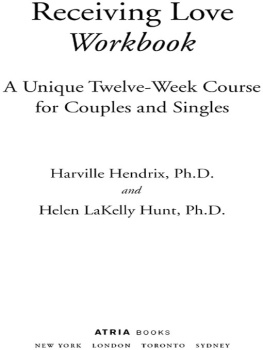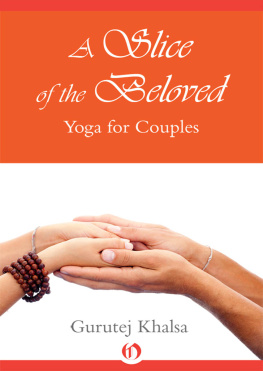Relax, Its Just Sex
Understanding Non-Possessive Intimate Relationships
Leslie Spurr, PhD

Copyright 2017 by Leslie Spurr, PhD
All rights reserved. No part of this publication may be reproduced, stored in a retrieval system, or transmitted, in any form or by any means, electronic, mechanical, photocopying, recording, or otherwise, except for the inclusion of brief quotations in a review, without prior permission in writing from the publisher.
Library of Congress Cataloging-in-Publication Data
Names: Spurr, Leslie, author.
Title: Relax, its just sex : understanding non-possessive intimate relationships / Leslie Spurr, PhD.
Description: Santa Barbara, California : Praeger, [2017] | Includes bibliographical references and index.
Identifiers: LCCN 2017002097 (print) | LCCN 2017015824 (ebook) | ISBN 9781440854743 (ebook) | ISBN 9781440854736 (hardback)
Subjects: LCSH: Non-monogamous relationships. | Sex. | Sexual freedom.
Classification: LCC HQ980 (ebook) | LCC HQ980 .S68 2017 (print) | DDC 306.7dc23
LC record available at https://lccn.loc.gov/2017002097
ISBN: 978-1-4408-5473-6
EISBN: 978-1-4408-5474-3
21 20 19 18 17 1 2 3 4 5
This book is also available as an eBook.
Praeger
An Imprint of ABC-CLIO, LLC
ABC-CLIO, LLC
130 Cremona Drive, P.O. Box 1911
Santa Barbara, California 93116-1911
www.abc-clio.com
This book is printed on acid-free paper 
Manufactured in the United States of America
To my research assistant, Lois.
Contents
Introduction
In this book, I describe a relatively new form of relationship style that appears to be increasingly prevalent among contemporary couples and singles.
In this bold new world, both men and women, and especially married couples, are discovering that they no longer need to demand sexual exclusivity as the essential requirement of a committed relationship. The insight, which has come to most of these adventurous couples, is that sexual fidelity may not only be unnecessary but possibly not even desirable in a long-term bonded relationship.
This revelation has created somewhat of a social/sexual reformation that has rippled across North America, Europe, and most Western countries. Starting from small numbers in the 1960s, this movement, emphasizing a non-possessive intimate relationship style, has gathered momentum, especially since the 1990s. It now represents a sizeable and well-established subculture, but one of which those in mainstream society are relatively unaware.
The purpose of this book is simply to describe this emerging phenomenon and to explain how it works, psychologically, for the couples and singles involved. As with any cultural change, new terms and concepts may emerge and, where relevant, I have defined and described these.
These nontraditional relationship styles may be expressed in many different ways and occur in several different contexts, depending on the preferences of the persons involved. I have tried to present these variations in some detail so that the reader may get a sense of the variety possible and some flavor of how these non-possessive arrangements actually work.
Although I have used male/female couples primarily for illustrative examples in this presentation, the same arrangements are, of course, utilized by many homoerotic couples. In fact, gays and lesbians pioneered these non-possessive intimate relationship styles before they became popular in the straight world.
In researching and preparing material for this book, I have functioned much like an anthropologist attempting to describe and explain, say, the mating rituals of some exotic tribe of natives. The natives here, however, may be your co-workers or next-door neighbors!
It is important to be aware of some significant limitations in the discussion that follows. The information and analysis presented here are not the result of a rigorous scientific survey. Investigations into peoples intimate behaviors are notoriously difficult to conduct and even when attempted are often susceptible to several types of shortcomings.
The interpretations and ideas that make up this brief overview arose from several sources. Chief among these sources were my work as a couples therapist, my review of the (very limited) relevant literature, and my direct observation of activities in these somewhat underground communities. (Ah, the joys of field research!)
In order to add a pinch of zest to the somewhat didactic descriptive material, I have included brief quotes taken from those I have spoken with as clients and interviewees. These are intended to illustrate, in more personal terms, the concepts being described and, at times, to add a touch of humor to the discussion.
In writing this book, I have tried to follow the advice of the first word in the title by adding attempts at amusement as a relaxing strategy. I hope you will be able to chuckle along with me as we poke gentle fun at all sides of this controversial issue.
This text is not intended primarily as a scholarly work. The statements made within are not buttressed by references to academic journal research or by footnotes detailing complex points of psychological theory.
As a book intended for a wider audience, it has been written to appeal to the more general reader who may have an interest in this topic. As such, the primary references I have used to illustrate and expand on the ideas being presented are to works in the popular media, such as movies, songs, novels, etc., which may be more widely known.
Like any good social scientist, I have tried to remain objective and non-judgmental, simply reporting my observations and attempting to offer plausible explanations for the dynamics of this social/sexual phenomenon. Please note that I am neither advocating nor condemning this relatively new form of coupling. I am simply describing it, FYI, with the hope that this presentation will shed light on a topic that has not been well-recognized or described previously.
I have tried to organize the material in a way that will allow the reader to best understand how non-possessive intimate relationships work. The first few chapters introduce some basic concepts. The next several chapters illustrate how these concepts are applied in various formats. The last chapters describe how those who are involved in these relationships attempt to get their needs met.
After perusing this book, many people will decide that this new morality is not for them. Others may be stimulated to explore these possibilities further. For those, the Notes and Bibliography may prove useful.
To all readers, I hope you will find this book both informative and entertaining and that you will enjoy reading it as much as I enjoyed researching and writing it.
CHAPTER ONE
Intimate Relationships
Exclusivity
Wilt thou, forsaking all others, keep thee only unto him/her so long as ye both shall live?
The Book of Common Prayer
We are all intimately familiar with how intimate relationships are supposed to work. We cant help but know the rules. From our earliest awareness, we are exposed to countless overt and covert messages from authority figures and the popular media telling us how we should meet someone, fall in love, get married, and live happily ever after, all the while being faithful to that one person.
A key element explicit in this idealized trajectory is the principle of exclusivity, i.e., one man, one woman (only!). Common wedding vow phrases, such as forsaking all others, express this commitment to ones one and only. This exclusivity model is so pervasive in our culture and so reinforced by popular song lyrics, Hollywood movies, books, poetry, and more that positive alternatives are barely, if at all, ever mentioned.
Next page








